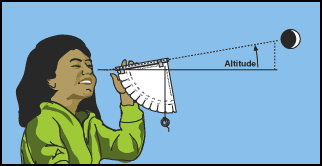|
|
E X P E R I M E N T 1
Measuring
the Altitude of Trees and Buildings |
 |
To
become familiar with how an astrolabe works, practice measuring
the altitude (angular height) of trees or buildings. To make a proper
measurement, look at the top of the object through the straw.
|
 |
Have
someone read the altitude in degrees from the side of the astrolabe.
The point where the string crosses the scale is the proper measurement.
|
 |
Practice
using your astrolabe by measuring and recording another tree or
building of a different height.
|
| |
 |
| |
Now
that you have an understanding of how an astrolabe works, you can
use it to measure the motion of the Sun. |
|
E
X P E R I M E N T 2
Measuring
the Altitude of the Sun
|
 |
Because
it is harmful to look directly at the Sun, a new method for measuring
the Sun's altitude must be used. Hold
the astrolabe so that the straw points in the direction of the Sun.
Do not look through the straw. |
 |
Aim
the straw so that you see the shadow of the straw on your hand.
Move the straw slightly until a small circle of light forms on your
hand. The straw is now pointing directly at the Sun.
|
 |
Ask
someone to read the Sun's altitude (in degrees) where the string
crosses the scale. Take note of the time of day the reading was
made.
|
 |
One
day a week, at the same time each day, measure the altitude of the
Sun with your astrolabe. Make three consecutive measurements and
record them in the chart provided. Be sure to include the date.
|
 |
As
the weeks progress, look at your measurements of the Sun's altitude.
Can you detect a change? Is the altitude increasing or decreasing?
Is there a pattern of change? How can you explain these changes? |
|
What's Going On
The
changes you notice will be different depending on the time of year.
In the spring, the altitude of the Sun increases. In the Fall, you
should notice a decrease.
The
cause of the change in altitude (i.e., the location of the Sun)
is the tilt of the Earth's axis, which causes the Earth to face
the Sun at an angle of 23 degrees. Where the Earth is located in
its orbit around the Sun will determine both the altitude of the
Sun at any given point in time and the length of the day. Since
the Earth's location around the Sun is changing continuously, so
is the Sun's position in the sky.
|
|
|
|
Activity
8: Using a Simple Astrolabe
Derived from "Making Measurements of Objects in the Sky": from Science
Resources for Schools: Doing Science, Vol 3, No. 1. Copyright
1985 by the American Association for the Advancement of Science
& the Smithsonian Institution.
|


